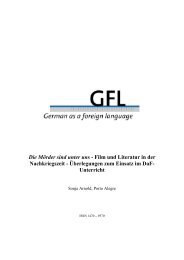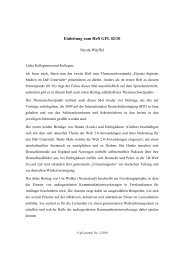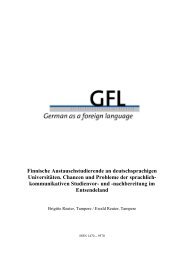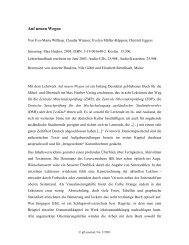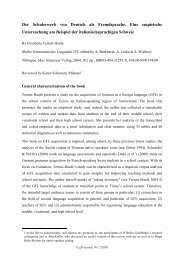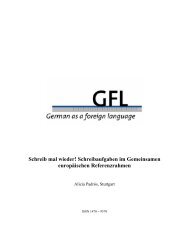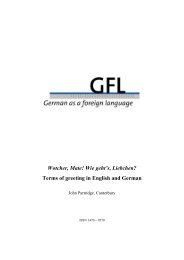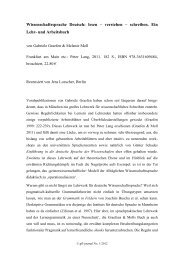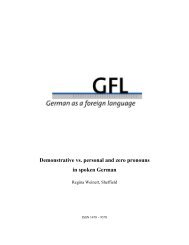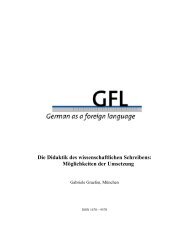Drama and Authentic Movement as Intercultural ... - GFL
Drama and Authentic Movement as Intercultural ... - GFL
Drama and Authentic Movement as Intercultural ... - GFL
Create successful ePaper yourself
Turn your PDF publications into a flip-book with our unique Google optimized e-Paper software.
<strong>Drama</strong> <strong>and</strong> <strong>Authentic</strong> <strong>Movement</strong> <strong>as</strong> <strong>Intercultural</strong> Communication Skill<br />
131<br />
Just formulating these questions is bound to raise even more questions, illustrating the<br />
complexity of this field of interest <strong>and</strong> the necessity for further scientific exploration.<br />
Finding <strong>and</strong> sketching the corner stones of this field is in itself a challenging t<strong>as</strong>k. Two<br />
central questions may be worth noting here: is it always the intercultural <strong>as</strong>pect that plays a<br />
key role in intercultural misunderst<strong>and</strong>ing <strong>and</strong> how can we identify it? <strong>Authentic</strong><br />
<strong>Movement</strong> could be another tool in developing an approach to answer these questions.<br />
Sixteen people from different European countries attended the workshop: language<br />
teachers, university lecturers, lecturers in drama-in-education <strong>and</strong> other people dealing with<br />
pedagogical <strong>and</strong> intercultural issues mentioned above. Due to time constraints I introduced<br />
<strong>and</strong> practised only the first guideline mentioned above. The other three were mentioned but<br />
not practised. However, the exercises done provided a means of experiencing the field of<br />
non-verbal intercultural <strong>and</strong> interpersonal underst<strong>and</strong>ing.<br />
4. Conclusion<br />
When trying to achieve intercultural communication the realisation that a particular gesture<br />
or posture may have a particular meaning for oneself <strong>and</strong> an entirely different one for<br />
another person is an essential b<strong>as</strong>is to start out from. As we move on to speech <strong>and</strong><br />
behaviour the individual differences incre<strong>as</strong>e, making it even more important to be very<br />
sensitive <strong>and</strong> clear from the beginning. The <strong>as</strong>pect of “(cultural) awareness” w<strong>as</strong> an issue<br />
which we discussed in the final round of our workshop, concentrating on the guidelines of<br />
<strong>Authentic</strong> <strong>Movement</strong>. What all participants came to realise w<strong>as</strong> how difficult it w<strong>as</strong> for<br />
them to exclusively observe a mover. Being a witness <strong>and</strong> a non-judgmental mirror w<strong>as</strong> a<br />
much more difficult t<strong>as</strong>k than the participants had expected.<br />
The guidelines of <strong>Authentic</strong> <strong>Movement</strong> offer a way of meeting the other in a safe<br />
framework. In everyday life, projections, interpretations <strong>and</strong> judgments fill our thoughts<br />
<strong>and</strong> may e<strong>as</strong>ily be an obstacle to any open-minded communication. Especially in an<br />
international context you may meet a ‘confusion of body-languages’ which often leads to<br />
misunderst<strong>and</strong>ings. We tend to interpret the other’s body language <strong>and</strong> behaviour from the<br />
perspective of our own social <strong>and</strong> cultural background <strong>and</strong> this may be a major re<strong>as</strong>on for<br />
mutual misunderst<strong>and</strong>ings. In using <strong>and</strong> practising the principles of <strong>Authentic</strong> <strong>Movement</strong>,<br />
© gfl-journal, No. 1/2004



